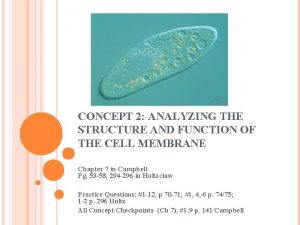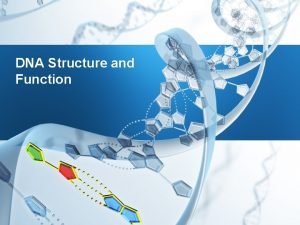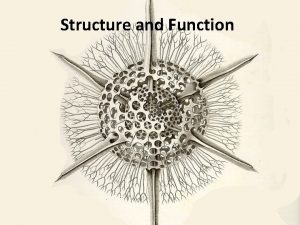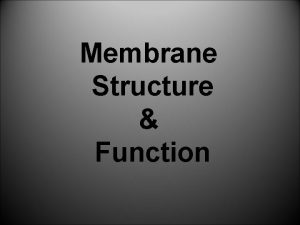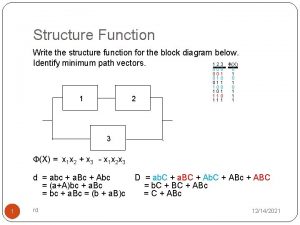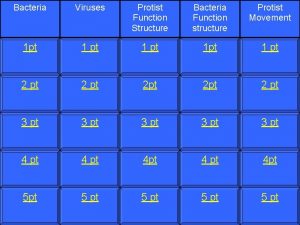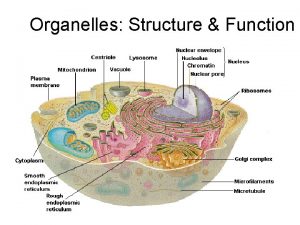CONCEPT 2 ANALYZING THE STRUCTURE AND FUNCTION OF
























- Slides: 24

CONCEPT 2: ANALYZING THE STRUCTURE AND FUNCTION OF THE CELL MEMBRANE Chapter 7 in Campbell Pg. 48 -52, 312 -315 in Holtzclaw Practice Questions: #8 -12, p 65 -66; 1 -2 p. 314 -315 Holtz All Concept Checkpoints (Ch 7), #1 -9 p. 141 Campbell


ANALYZING THE STRUCTURE AND FUNCTION OF THE CELL MEMBRANE You must know: Why membranes are selectively permeable. The role of phospholipids, proteins, and carbohydrates in membranes. How water will move if a cell is placed in an isotonic, hypertonic, or hypotonic solution. How electrical gradients are formed.

ANALYZING THE STRUCTURE AND FUNCTION OF THE CELL MEMBRANE AP Lab 1: Diffusion and Osmosis Factors that influence diffusion across the membrane. How water potential is measured and its relationship to solute concentrations and pressure potential of a solution. Water moves from a region where water potential is high to a region where water potential is low. The relationship of molarity to osmotic concentration. How to determine osmotic concentration of a solution from experimental data.

HOW WATER WILL MOVE IF A CELL IS PLACED IN AN ISOTONIC, HYPERTONIC, OR HYPOTONIC SOLUTION? Lab 1: Diffusion and Osmosis Set Up! What do you predict? 15% glucose & 1% starch Distilled water & IKI Answer Analysis Questions 1 -5 by next class For Next Class: FLOW CHART for 1 B, C, D, and E

ANY QUESTIONS FROM THE WORKSHEETS?

TRY THIS! Which molecular movements are due to diffusion or osmosis? a. Ten minutes after a perfume bottle is dropped in a room, a person can smell the scent in the opposite corner of the room. b. Oxygen moves from an alveolus into a capillary within the lung. c. When a plant cell is placed in salt water, water moves out of the central vacuole of the cell. d. When a cell is placed in a solution that is hypotonic to the cell contents, water moves into the cell through an aquaporin channel.

TRY THIS! Which molecular movements are due to diffusion or osmosis? a. Ten minutes after a perfume bottle is dropped in a room, a person can smell the scent in the opposite corner of the room. b. Oxygen moves from an alveolus into a capillary within the lung. c. When a plant cell is placed in salt water, water moves out of the central vacuole of the cell. d. When a cell is placed in a solution that is hypotonic to the cell contents, water moves into the cell through an aquaporin channel.

WHY ARE MEMBRANES SELECTIVELY PERMEABLE? Cell (plasma) membranes allow some substances to cross more easily than others Fundamental to Life! Due to the chemistry of the phospholipid bilayer and embedded proteins

WHAT IS THE ROLE OF PHOSPHOLIPIDS, PROTEINS, AND CARBOHYDRATES IN MEMBRANES? Phospholipids

WHAT IS THE ROLE OF PHOSPHOLIPIDS, PROTEINS, AND CARBOHYDRATES IN MEMBRANES? Proteins Globular shape! Primary, secondary, tertiary (and sometimes quaternary) level of structure Shape determines function

WHAT IS THE ROLE OF PHOSPHOLIPIDS, PROTEINS, AND CARBOHYDRATES IN MEMBRANES? Proteins are embedded in the phospholipid bilayer with their hydrophophic and hydrophilic regions

WHAT IS THE ROLE OF PHOSPHOLIPIDS, PROTEINS, AND CARBOHYDRATES IN MEMBRANES? Proteins are embedded in the phospholipid bilayer with their hydrophophic and hydrophilic regions AP Theme: Science as a Process

WHAT IS THE ROLE OF PHOSPHOLIPIDS, PROTEINS, AND CARBOHYDRATES IN MEMBRANES? Proteins Move sideways within the plane of the phospholipid bilayer AP Theme: Science as a Process

WHAT IS THE ROLE OF PHOSPHOLIPIDS, PROTEINS, AND CARBOHYDRATES IN MEMBRANES? Proteins Many different functions

WHAT IS THE ROLE OF PHOSPHOLIPIDS, PROTEINS, AND CARBOHYDRATES IN MEMBRANES? Carbohydrates Used for cell-to-cell signalling Can be attached to phospholipids: GLYCOLIPIDS Can be attached to proteins: GLYCOPROTEINS

WHAT IS THE ROLE OF PHOSPHOLIPIDS, PROTEINS, AND CARBOHYDRATES IN MEMBRANES? Carbohydrates Attachment to lipids or proteins

HOW WATER WILL MOVE IF A CELL IS PLACED IN AN ISOTONIC, HYPERTONIC, OR HYPOTONIC SOLUTION? You need to know the following terms: Diffusion Osmosis Facilitated diffusion Concentration gradient Isotonic solution Hypertonic solution Hypotonic solution

HOW ELECTRICAL GRADIENTS ARE FORMED? You need to know the following terms: Active transport Sodium-potassium pump Membrane potential Electrochemical gradient Electrogenic pump Cotransport Exocytosis Endocytosis Phagocytosis Pinocytosis Receptor-mediated endocytosis

CHECKPOINT IN THREE CLASSES Wed: Lab Fri: Lab Wed: Checkpoint

WHAT DO YOU THINK OF THESE QUESTIONS? Identify each statement as TRUE or FALSE. a. If a dead cell is placed in a solution hypotonic to the cell contents, osmosis will not occur. False b. When two solutions separated by a selectively permeable membrane reach osmotic equilibrium, water molecules no longer move between the solutions. False c. The rate of osmosis increases with increasing differences in solute concentrations between two solutions separated by a selectively permeable membrane. True d. Osmosis is due to diffusion of water molecules across a selectively permeable membrane. True e. Hydrostatic pressure applied to a hypertonic solution separated from a hypotonic solution by a selectively permeable membrane opposes osmotic movement across the membrane. True

WHAT DO YOU THINK OF THESE QUESTIONS? Identify each statement as TRUE or FALSE. a. If a dead cell is placed in a solution hypotonic to the cell contents, osmosis will not occur. b. When two solutions separated by a selectively permeable membrane reach osmotic equilibrium, water molecules no longer move between the solutions. c. The rate of osmosis increases with increasing differences in solute concentrations between two solutions separated by a selectively permeable membrane. d. Osmosis is due to diffusion of water molecules across a selectively permeable membrane. e. Hydrostatic pressure applied to a hypertonic solution separated from a hypotonic solution by a selectively permeable membrane opposes osmotic movement across the membrane.

WHAT DO YOU THINK OF THESE QUESTIONS? Are these statements correct or incorrect? 1. Osmosis can take place if a dead cell is placed in a solution hypotonic to the cell contents. 2. Water movement into a cell through aquaporin channels requires energy investment by the cell. 3. A solution of distilled water is hypotonic. 4. Diffusion is due to random movements of molecules.

WHAT DO YOU THINK OF THESE QUESTIONS? 1. Osmosis can take place if a dead cell is placed in a solution hypotonic to the cell contents. Correct 2. Water movement into a cell through aquaporin channels requires energy investment by the cell. Incorrect – Water moves into a cell through aquaporin channels by diffusion, which does not require energy investment by the cell. 3. A solution of distilled water is hypotonic. Incorrect – A solution of distilled water is hypotonic to water containing solute molecules. 4. Diffusion is due to random movements of molecules. Correct
 Hát kết hợp bộ gõ cơ thể
Hát kết hợp bộ gõ cơ thể Bổ thể
Bổ thể Tỉ lệ cơ thể trẻ em
Tỉ lệ cơ thể trẻ em Gấu đi như thế nào
Gấu đi như thế nào Thang điểm glasgow
Thang điểm glasgow Chúa sống lại
Chúa sống lại Môn thể thao bắt đầu bằng chữ f
Môn thể thao bắt đầu bằng chữ f Thế nào là hệ số cao nhất
Thế nào là hệ số cao nhất Các châu lục và đại dương trên thế giới
Các châu lục và đại dương trên thế giới Công thức tính độ biến thiên đông lượng
Công thức tính độ biến thiên đông lượng Trời xanh đây là của chúng ta thể thơ
Trời xanh đây là của chúng ta thể thơ Cách giải mật thư tọa độ
Cách giải mật thư tọa độ 101012 bằng
101012 bằng Phản ứng thế ankan
Phản ứng thế ankan Các châu lục và đại dương trên thế giới
Các châu lục và đại dương trên thế giới Thơ thất ngôn tứ tuyệt đường luật
Thơ thất ngôn tứ tuyệt đường luật Quá trình desamine hóa có thể tạo ra
Quá trình desamine hóa có thể tạo ra Một số thể thơ truyền thống
Một số thể thơ truyền thống Cái miệng nó xinh thế chỉ nói điều hay thôi
Cái miệng nó xinh thế chỉ nói điều hay thôi Vẽ hình chiếu vuông góc của vật thể sau
Vẽ hình chiếu vuông góc của vật thể sau Biện pháp chống mỏi cơ
Biện pháp chống mỏi cơ đặc điểm cơ thể của người tối cổ
đặc điểm cơ thể của người tối cổ V cc cc
V cc cc Vẽ hình chiếu đứng bằng cạnh của vật thể
Vẽ hình chiếu đứng bằng cạnh của vật thể


























